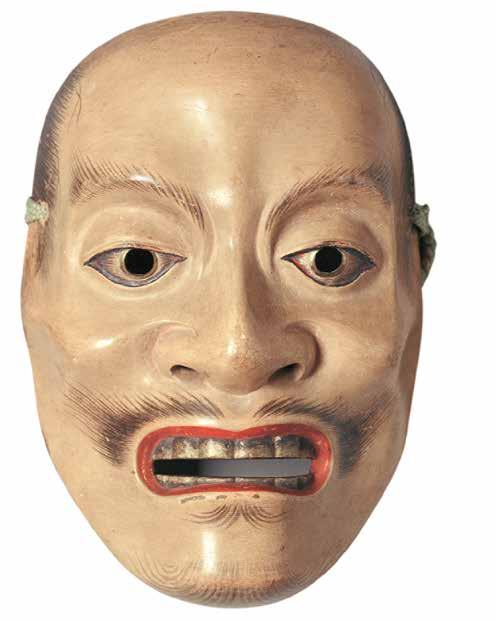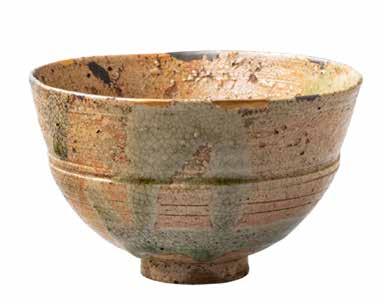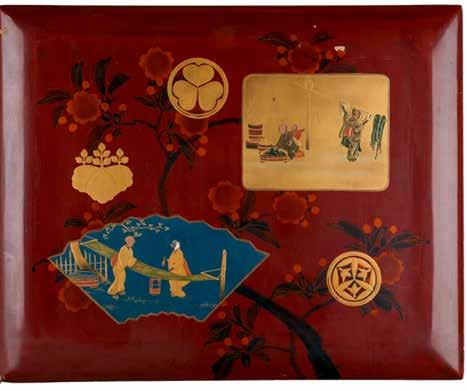
7 minute read
The quest for beauty amidst the ashes: the creation of samurai culture
Russell Kelty
The world is all a dream, and he who wakes the world is all a dream, and he wakes, casting it from him, may yet know the real.
Advertisement
(The monk Rensho, formerly the Minamoto warrior Kumagai, from the Nō play, Atsumori)
In a small mountain retreat nestled in the eastern hills of Kyoto, a failed shogun’s passion for the arts inspired a renaissance amidst the chaos of war. As the power of regional daimyo expanded and the shogunate faltered, Ashikaga Yoshimasa (1436–1490) surrounded himself with the foremost Nō playwrights, tea masters and gardeners, and in his Silver Pavilion experimented with new types of interior architecture and displays. He was an artistic connoisseur of rare sensitivity and the culture which blossomed under his guidance and patronage shaped the tastes and pursuits of future shogun, daimyo and samurai. The new aesthetic was defined as mysterious and tinged with a recognition of impermanence and has been described as the ‘the soul of Japan’. 1 The calamitous historical events that inspired The Tale of the Heike ushered in the era of the samurai and the decline of the influence of the aristocracy in Kyoto. The victorious leader, Minamoto no Yoritomo (1147–1199), established Japan’s first warrior government (bakufu) in Kamakura on the east coast of Japan and assumed the title of shogun, the Emperor’s military commander. For the next 600 years the archipelago was ruled and administered by a succession of hereditary military governments, which recognised the legitimacy of the Emperor.
Over time, the bakufu in Kamakura established offices in Kyoto and wielded such considerable influence that they were able to select emperors, control imperial appointments and maintain control over the regional provinces. 2 The first code of the samurai was written to deal with disputes over land and religious and criminal disputes (joei shikimoku) and recognised the separate function of the imperial court. 3
The new military ethos, described as ‘violent and masculine’ (masuraoburi), contrasted with the ‘gentle and feminine’ (taoyameburi) culture of the Kyoto aristocracy. 4 However, the military elite indulged in the pursuits of the court and were ‘more likely to compose poetry on the beauty of falling cherry blossoms than on the joys of victory in battle’. 5 The literature of the period reflected the interests of the samurai and was infused with a sense of pessimism and a recognition of impermanence, encapsulated in the widespread belief that Japanese society had entered a degenerate age of Buddhism (mappō) and had narrowly escaped the Mongol hordes who were turned away by divine winds (kamikaze). 6
1
2
3
4 5
6 Donald Keene, Yoshimasa and the silver pavilion: the creation of the soul of Japan, Columbia University Press, New York, 2003. Seiitaishogun (Supreme commander against the barbarians), shogun, is the term most commonly used to refer to the heads of three samurai governments (‘shogunates’ or bakufu) which ruled Japan 1192–1333, 1336–1573, 1615–1868. John Stevenson, ‘The warrior in Japanese history’, in J. Gabriel Barbier-Mueller (ed.), Art of armor: Samurai armor from the Ann and Gabriel BarbierMueller Collection, Yale University Press, New Haven, 2011, p. 35. Stevenson, p. 36. Ryusaku Tsunoda, W.T. De Bary & D. Keene, Sources of the Japanese tradition, Columbia University Press, New York, 2001, p. 364. According to Buddhist beliefs, the period following the death of the historical Buddha is divided into three ages and mappō is the last and final age, which began in 1052 CE and will end with the arrival of the buddha-to-be, who will restore the dharma.
The aesthetic vocabulary established by the aristocracy to describe courtliness and refinement (miyabi) intensified and darkened. The term yūgen is often translated as ‘deep mystery’ and can be used to describe art forms that evoke the stirring of emotions, which cannot be fully expressed in words. Of all art forms, it was the subtle beauty of Nō theatre (fig. 1) that captured the ethos of yūgen and was aptly described by the great playwright Zeami Motokiyo (c.1363–c.1443):
To watch the sun sink behind a flower clad hill. To wander on in a huge forest without thought of return. To stand upon the shore and gaze after a boat that disappears behind distant islands. To contemplate the flight of wild geese seen and lost among the clouds …
To achieve yūgen, works of art were required to be stripped of colour and glitter and achieve a stillness. Other terms such as sabi, appear in the earliest compilations of poetry, as well as in The Tale of the Heike, and refer to objects that had acquired the patina of age or rusticity. These terms were influenced by new forms of Buddhism.
The ascension of the samurai as the de facto rulers of Japan coincided with the emergence of new Buddhist lineages and schools, which advocated a more direct path to salvation and enlightenment. Pure Land Buddhism and Zen (ch: chan) Buddhism became increasingly popular. Zen, which was transmitted from India to China and then on to Japan, found favour with the new military government. Vast temple complexes were established in both Kamakura and Kyoto. From the beginning, Zen Buddhism was influenced by existing esoteric practices, featuring wrathful protectors such as Fudō Myōō (p. 43).
Zen practice elevates the discovery of the inner ‘Buddha’ within oneself over the worship of Buddhist icons. An emphasis was placed on the teacher–pupil relationship, which paralleled the loyalty of samurai to their lords. Zen also offered the opportunity for instantaneous enlightenment (satori), which required a type of discipline familiar to the samurai and their daily pursuit of martial perfection.
fig. 1: Japan, Nō mask of Togo, c.1700, Kyoto, cypress wood, lacquer, gilt-copper alloy, 20.3 x 13.9 cm; Bequest of Mrs Alex Tweedie 1940
Zen temples acted as a window for the reception of prominent trends in poetry and painting from China and served as repositories for a wealth of art and culture. The arts of the brush (poetry, painting and calligraphy) merged into one format – hanging and hand scrolls (fig. 2). The patriarchs of Zen Buddhism, Daoist immortals and seasonal landscapes were prominent themes among artist monks. The most evocative are the complementary pair of dragon and tiger, which appear widely in the interior decoration of temples.
Tea, in the form of powder, was introduced for a second time to Japan from China as an aid to meditation among Buddhist monks. The elevation of tea from a drink to an artistic pursuit and ritual was influenced by monastic rules, leading to the common saying ‘tea and Zen have the same flavour’. The way of tea (chadō or chanoyu) was literally shaped by the architecture of the Silver Pavilion. Although the ritual of tea originally featured Chinese ceramics and utensils, the influential tea master, Murata Jukō (died 1502), who transformed the tea ceremony in the late fifteenth century, initiated
Unkoku Tōgan, born Saga prefecture, Japan 1547, died Japan 1618, Daruma, c.1600, Japan, hanging scroll; ink and natural pigments on paper, 205.0 x 67.5 cm (overall); Gift of M.J.M. Carter AO through the Art Gallery of South Australia Foundation 2018
fig. 3: Japan, Tray, negoro ware, c.1700, lacquer on wood, 6.5 x 42.0 cm (diam.); Gift of James and Diana Ramsay 1972
fig. 4: Japan, Tea bowl (chawan) named Morning Light (Akebono), 17th century, earthenware, ash glaze, gold, silver mends, 8.0 x 13.0 cm (diam.); M.J.M. Carter AO Collection through the Art Gallery of South Australia Foundation 2019

a taste for the imperfection of Japanese utensils that evoked a simple, unpretentious beauty (wabi). Murata elevated the ‘cold, withered and shrunken’ to represent artistic transcendence, and, according to him, ‘no art worthy of the name, is intelligible to persons of shallow understanding’ (fig. 3). Murata believed that, upon entering his small and austerely appointed tearoom, the trappings of daily life, particularly one’s status, must be discarded, as each participant was considered equal. He also imbued his tea ritual with performative elements from Nō theatre and the philosophy of Zen Buddhism, which placed an emphasis on the communal nature of life. The most striking element of the ceremony was that participants were often required to use the same tea bowl. These were authentic rustic wares from Japanese or Korean kilns rather than luxurious porcelains from China (fig. 4). As a result, tea bowls became the most prominent utensils of Murata’s wabi-cha, with the most spectacular examples coveted by the wealthy merchants of Sakai and powerful daimyo seeking to express their own prestige and power. For the samurai the way of tea would become essential to their lifestyle and essential for cultivating their own aesthetic sensibilities.












